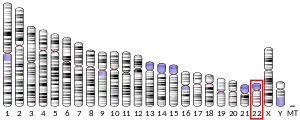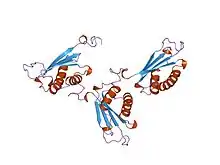| DDT | |||||||||||||||||||||||||||||||||||||||||||||||||||
|---|---|---|---|---|---|---|---|---|---|---|---|---|---|---|---|---|---|---|---|---|---|---|---|---|---|---|---|---|---|---|---|---|---|---|---|---|---|---|---|---|---|---|---|---|---|---|---|---|---|---|---|
 | |||||||||||||||||||||||||||||||||||||||||||||||||||
| |||||||||||||||||||||||||||||||||||||||||||||||||||
| Identifiers | |||||||||||||||||||||||||||||||||||||||||||||||||||
| Aliases | DDT, DDCT, D-dopachrome tautomerase, MIF-2, MIF2, D-DT | ||||||||||||||||||||||||||||||||||||||||||||||||||
| External IDs | OMIM: 602750 MGI: 1298381 HomoloGene: 1038 GeneCards: DDT | ||||||||||||||||||||||||||||||||||||||||||||||||||
| |||||||||||||||||||||||||||||||||||||||||||||||||||
| |||||||||||||||||||||||||||||||||||||||||||||||||||
| |||||||||||||||||||||||||||||||||||||||||||||||||||
| |||||||||||||||||||||||||||||||||||||||||||||||||||
| |||||||||||||||||||||||||||||||||||||||||||||||||||
| Wikidata | |||||||||||||||||||||||||||||||||||||||||||||||||||
| |||||||||||||||||||||||||||||||||||||||||||||||||||
D-dopachrome decarboxylase is an enzyme that in humans is encoded by the DDT gene.[5][6][7]
D-dopachrome tautomerase converts D-dopachrome into 5,6-dihydroxyindole. The DDT gene is related to the macrophage migration inhibitory factor (MIF) in terms of sequence, enzyme activity, and gene structure. DDT and MIF are closely linked on chromosome 22.[7]
See also
References
- 1 2 3 ENSG00000275003 GRCh38: Ensembl release 89: ENSG00000099977, ENSG00000275003 - Ensembl, May 2017
- 1 2 3 GRCm38: Ensembl release 89: ENSMUSG00000001666 - Ensembl, May 2017
- ↑ "Human PubMed Reference:". National Center for Biotechnology Information, U.S. National Library of Medicine.
- ↑ "Mouse PubMed Reference:". National Center for Biotechnology Information, U.S. National Library of Medicine.
- ↑ Nishihira J, Fujinaga M, Kuriyama T, Suzuki M, Sugimoto H, Nakagawa A, Tanaka I, Sakai M (Mar 1998). "Molecular cloning of human D-dopachrome tautomerase cDNA: N-terminal proline is essential for enzyme activation". Biochem Biophys Res Commun. 243 (2): 538–44. doi:10.1006/bbrc.1998.8123. PMID 9480844.
- ↑ Coggan M, Whitbread L, Whittington A, Board P (Nov 1998). "Structure and organization of the human theta-class glutathione S-transferase and D-dopachrome tautomerase gene complex". Biochem J. 334. ( Pt 3) (3): 617–23. doi:10.1042/bj3340617. PMC 1219731. PMID 9729470.
- 1 2 "Entrez Gene: DDT D-dopachrome tautomerase".
Further reading
- Hochstrasser DF, Frutiger S, Paquet N, et al. (1993). "Human liver protein map: a reference database established by microsequencing and gel comparison". Electrophoresis. 13 (12): 992–1001. doi:10.1002/elps.11501301201. PMID 1286669. S2CID 23518983.
- Odh G, Hindemith A, Rosengren AM, et al. (1994). "Isolation of a new tautomerase monitored by the conversion of D-dopachrome to 5,6-dihydroxyindole". Biochem. Biophys. Res. Commun. 197 (2): 619–24. doi:10.1006/bbrc.1993.2524. PMID 8267597.
- Esumi N, Budarf M, Ciccarelli L, et al. (1999). "Conserved gene structure and genomic linkage for D-dopachrome tautomerase (DDT) and MIF". Mamm. Genome. 9 (9): 753–7. doi:10.1007/s003359900858. PMID 9716662. S2CID 24034990.
- Sugimoto H, Taniguchi M, Nakagawa A, et al. (1999). "Crystal structure of human D-dopachrome tautomerase, a homologue of macrophage migration inhibitory factor, at 1.54 A resolution". Biochemistry. 38 (11): 3268–79. doi:10.1021/bi982184o. PMID 10079069.
- Dunham I, Shimizu N, Roe BA, et al. (1999). "The DNA sequence of human chromosome 22". Nature. 402 (6761): 489–95. Bibcode:1999Natur.402..489D. doi:10.1038/990031. PMID 10591208.
- Lubetsky JB, Dios A, Han J, et al. (2002). "The tautomerase active site of macrophage migration inhibitory factor is a potential target for discovery of novel anti-inflammatory agents". J. Biol. Chem. 277 (28): 24976–82. doi:10.1074/jbc.M203220200. PMID 11997397.
- Strausberg RL, Feingold EA, Grouse LH, et al. (2003). "Generation and initial analysis of more than 15,000 full-length human and mouse cDNA sequences". Proc. Natl. Acad. Sci. U.S.A. 99 (26): 16899–903. Bibcode:2002PNAS...9916899M. doi:10.1073/pnas.242603899. PMC 139241. PMID 12477932.
- Gevaert K, Goethals M, Martens L, et al. (2004). "Exploring proteomes and analyzing protein processing by mass spectrometric identification of sorted N-terminal peptides". Nat. Biotechnol. 21 (5): 566–9. doi:10.1038/nbt810. PMID 12665801. S2CID 23783563.
- Sonesson B, Rosengren E, Hansson AS, Hansson C (2004). "UVB-induced inflammation gives increased d-dopachrome tautomerase activity in blister fluid which correlates with macrophage migration inhibitory factor". Exp. Dermatol. 12 (3): 278–82. doi:10.1034/j.1600-0625.2003.120307.x. PMID 12823441. S2CID 12494872.
- Collins JE, Wright CL, Edwards CA, et al. (2005). "A genome annotation-driven approach to cloning the human ORFeome". Genome Biol. 5 (10): R84. doi:10.1186/gb-2004-5-10-r84. PMC 545604. PMID 15461802.
- Gerhard DS, Wagner L, Feingold EA, et al. (2004). "The status, quality, and expansion of the NIH full-length cDNA project: the Mammalian Gene Collection (MGC)". Genome Res. 14 (10B): 2121–7. doi:10.1101/gr.2596504. PMC 528928. PMID 15489334.
- Ewing RM, Chu P, Elisma F, et al. (2007). "Large-scale mapping of human protein-protein interactions by mass spectrometry". Mol. Syst. Biol. 3 (1): 89. doi:10.1038/msb4100134. PMC 1847948. PMID 17353931.
This article is issued from Wikipedia. The text is licensed under Creative Commons - Attribution - Sharealike. Additional terms may apply for the media files.





